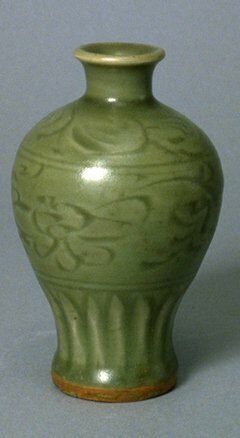Vase
Chinese

Description
Subject Matter:
A longquan celadon bottle-vase of meiping (梅瓶) form, named thus because its shape is suitable to hold a branch of prunus blossom, of the Ming dynasty (1368-1644).
Longquan is the most representative, widespread, and esteemed ware of the Southern Song dynasty (1127–1279). Production started during the Five Dynasties period (907–960) at the kilns near the market town of Longquan, where in later dynasties much of the ware was collected for shipping. Technological advances such as the development of a multi-chambered, rising kiln and the use of stacked saggars—protective clay boxes—allowed for increased production in the Southern Song. In Yuan (1279–1368) and Ming (1368–1644) times, the kilns supplied wares to a domestic market as well as to overseas markets in Korea, Japan, and Southeast Asia.
Physical Description:
A stoneware vase on a narrow, tapered base with high, wide shoulders and a small narrow flaring neck with everted lip. The vase is carved with lotus petal lappets around the base and floral meander around the body and shoulder, and is covered with a green celadon glaze.
Usage Rights:
If you are interested in using an image for a publication, please visit https://umma.umich.edu/request-image/ for more information and to fill out the online Image Rights and Reproductions Request Form.